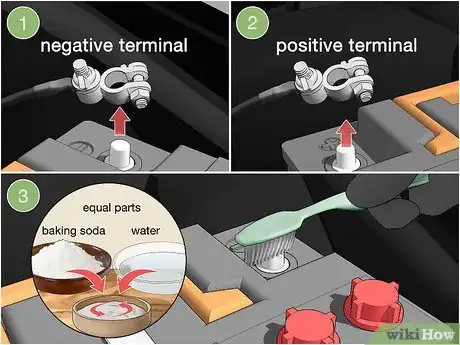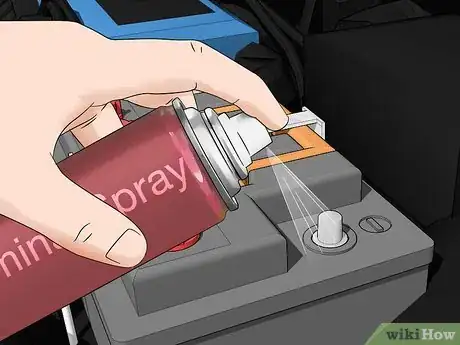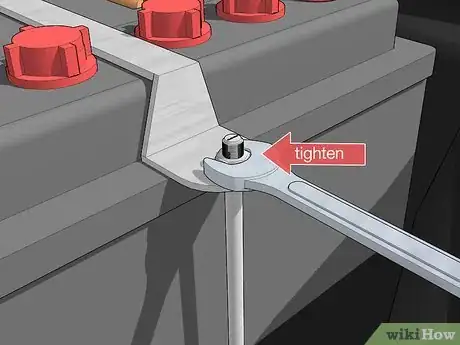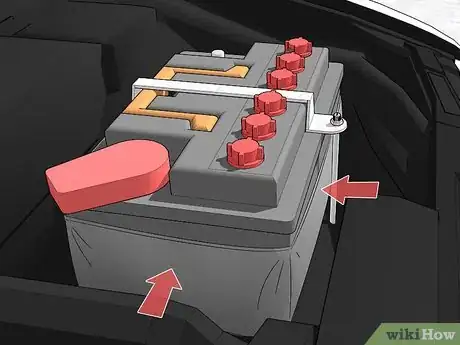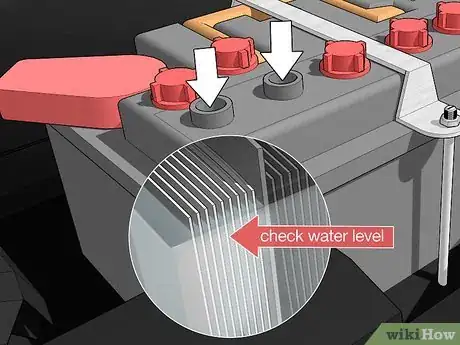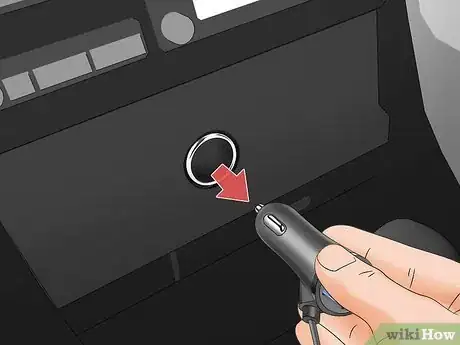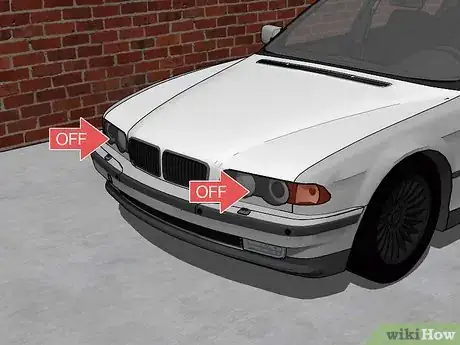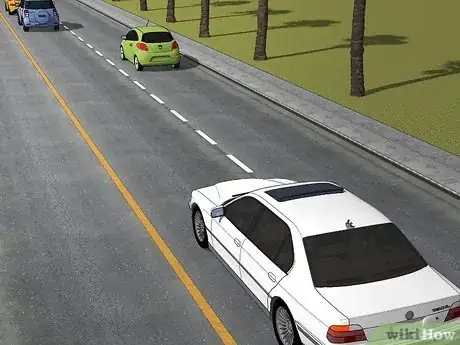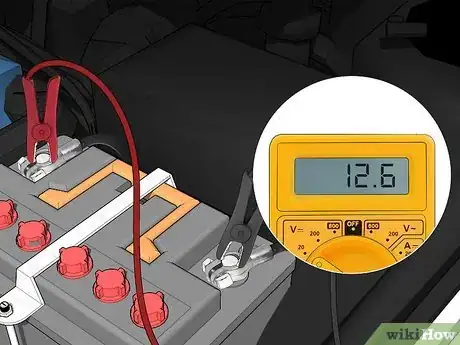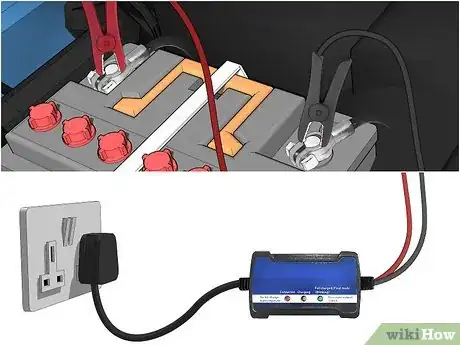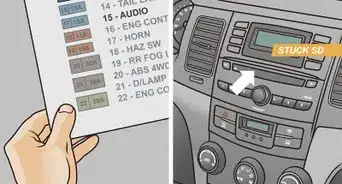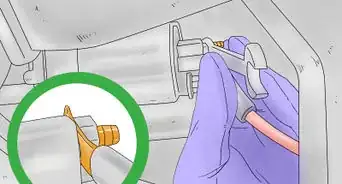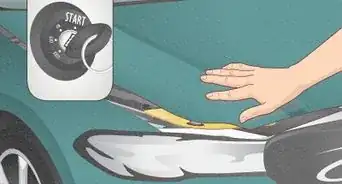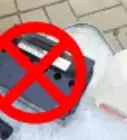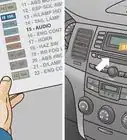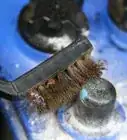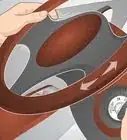This article was co-authored by Hovig Manouchekian. Hovig Manouchekian is an Auto Repair and Design Specialist and the Manager of Funk Brothers Auto, a family-owned business operated since 1925. With over 30 years of experience in the automotive industry, Hovig specializes in the process of auto repair and maintenance. He is also very knowledgeable in common automotive issues and needs including engine repair, battery replacement, and windshield accessory and maintenance. Hovig's knowledge and hard work have contributed to Funk Brothers Auto winning Angie's List Super Service Award for five consecutive years.
There are 8 references cited in this article, which can be found at the bottom of the page.
This article has been viewed 137,414 times.
The car battery stores the electrical energy necessary to start the ignition and keep the car running. Naturally, you want to avoid getting stuck by a dead battery, so there are many steps you can take to keep your battery in good working order. Clean the battery regularly, tighten the hold-down, use insulation to protect it from the cold, and maintain its fluid levels. To maintain the charge, drive the car often and unplug any appliances when the car isn't running. With good care, your battery can last 5 to 7 years.[1]
Steps
Performing Battery Maintenence
-
1Clean the battery terminals with water and baking soda. First, identify the positive side of the battery by finding the red cap. Always disconnect the negative side first. Turn the bolt connecting the wires to the negative terminal counterclockwise and lift the wire up. Do the same for the positive side, making sure you don't touch the 2 wires to any metal parts of the car. Then make a 1:1 mixture of baking soda and water. Dip a hard-bristle brush into the solution and scrub both battery terminals.
- Wipe the terminals down with a wet rag when you're done.
- Remember to reconnect the battery properly when you’re finished. Always reconnect the positive terminal first.
- Rust and corrosion on the battery terminals inhibits its performance and lifespan.
-
2Coat the battery terminals in terminal spray to prevent corrosion. After you’ve cleaned the battery terminals, protect them from further corrosion with terminal spray. Hold the can 4 inches (10 cm) from the terminal and spray until the connection is coated. Then spray the other terminal.[2]
- Spray after the battery is reconnected to protect the terminal and connection point from corrosion.
- Terminal spray is available from auto parts stores. Only use products that are designed for use on battery terminals.
Advertisement -
3Tighten the hold-down to prevent the battery from rattling around. Excessive vibration can damage the battery over time. The hold-down bar keeps the battery stable and prevents vibration damage. Test your battery hold-down by opening the hood and shaking the battery. If the battery moves, the hold-down is too loose. Locate the bolts connecting the hold-down to the battery. They're usually along the top of the battery, where the hold-down bar stretches across. Use a socket wrench and turn the bolts clockwise to tighten them.[3]
- There are different types of hold-downs on different cars. The most common type is a bar stretching across the top of the battery. This is easy to locate. Some cars use a hold-down pad instead. These are along the base of the battery. Look here if you don't see a bar across the top of the battery.[4]
- If the hold-down is damaged in any way, replace it right away. New parts are available at auto parts stores.
-
4Wrap the battery in a battery heater to prevent damage from the cold. If you live in a cold climate or winter is on its way, a battery heater can prevent your battery from dying in the cold. These are basically jackets that fit over the battery and keep it warm. Get a battery warmer from your auto parts store and follow the installation instructions for the product.[5]
- There are 2 main types of battery warmers. The first is insulated fabric that wraps around the battery. These are cheaper but less effective. The second is a rubber wrapping that inflates when you plug it in. This provides more insulation for the battery.
- For some warmers, you have to remove the battery completely to cover it. On others, the warmer wraps around the battery while it’s still installed. Follow the instructions on whichever product you use.
-
5Check the battery fluid level and add distilled water if it’s low. Unscrew the vent caps on top of the battery and look inside each cell with a flashlight. The fluid should cover the battery plates. If it doesn’t, the level is too low. Pour in distilled water until the water covers the battery plates and reaches the bottom of the cell refill holes.
- Wipe off any excess fluid with a rag before replacing the vent caps. Wipe away from the cells to prevent getting dirt inside your battery.
- You may have to use a flathead screwdriver to pop the vent caps off. Remember to put them back on securely.
- Only use distilled water, not tap water. Tap water has dissolved minerals that will affect the battery’s performance.
- Check the battery fluid levels every time you do an oil change, or roughly every 6 months.
-
6Buy a battery that’s less than a month old when you replace yours. When it does come time to change the battery, always get a new one. Look on the side of the battery for the manufacture date. Find one that was manufactured within the last month for the best battery performance.[6]
- Getting a new battery is important because they deteriorate over time. A battery more than 1 month old will probably last a shorter time than a brand new one.
- Avoid buying a used, discount battery. These will almost certainly not last very long.
Maintaining the Battery Charge
-
1Unplug any appliances when the car isn't running. When the car isn't running, appliances pull power directly from the battery. Unplug all cell phones, GPS navigators, or any other appliances plugged into the charging port once you turn the car off. Don’t plug anything back in until you start the car again.[7]
- Don’t leave anything plugged in while the car is off. This could drain the power and result in a dead battery.
-
2Turn off the headlights and interior lights when the engine is off. Just like appliances, these lights pull power directly from the battery when the car isn’t running. Once you turn the car off, turn off all the lights that are on. Don’t start them up again until you start the engine.[8]
- Double check to make sure your headlights are off before walking away from the car.
-
3Drive the car regularly to keep the battery charged. Car batteries recharge when you drive, so don’t leave the car sitting for weeks at a time. Take drives of at least 20 minutes once a week to give your battery enough time to recharge.[9]
- If you can’t drive the car for any reason, let it run for 20 minutes without moving. It’s not an ideal solution, but it will help the battery stay charged.
-
4Keep your battery charged to 12.6 volts. This is the ideal voltage for a battery charge. If the battery falls below this level, its performance and lifespan will decrease. Get a voltmeter and connect the positive lead (red) to the battery's positive terminal and the negative lead (black) to the negative terminal. Hold them there for a few seconds and wait for the meter to produce a reading.[10]
- If the charge is below 12.6 volts, connect a battery charger by attaching the negative lead to the negative lead first, then connect the positive lead to the positive terminal. Recharge the battery to 12.6 volts.
- Always wear rubber gloves when testing and charging the battery.
- Test your battery every 6 months. Do it at least once when the weather has been cold because low temperatures can decrease the battery charge.
-
5Attach a trickle charger to the battery if you don’t use it for long periods. A trickle charger hooks into a power outlet and provides a steady charge to the battery. This keeps the battery at the correct charge even when you don’t drive the car. It’s a useful appliance for cars that aren’t driven often. Connect the trickle charger the same way you could connect a normal charger. Hook the negative lead to the negative terminal first, then connect the positive lead. Then plug the charger in. Leave it attached until you drive the car again.[11]
- Trickle chargers are popular among owners of rare or collectible cars that they don’t drive often.
- It’s best to use the trickle charger when the car is in a garage. This prevents debris from getting under the hood.
Expert Q&A
-
QuestionWhat should I keep in mind when replacing a car battery?
 Hovig ManouchekianHovig Manouchekian is an Auto Repair and Design Specialist and the Manager of Funk Brothers Auto, a family-owned business operated since 1925. With over 30 years of experience in the automotive industry, Hovig specializes in the process of auto repair and maintenance. He is also very knowledgeable in common automotive issues and needs including engine repair, battery replacement, and windshield accessory and maintenance. Hovig's knowledge and hard work have contributed to Funk Brothers Auto winning Angie's List Super Service Award for five consecutive years.
Hovig ManouchekianHovig Manouchekian is an Auto Repair and Design Specialist and the Manager of Funk Brothers Auto, a family-owned business operated since 1925. With over 30 years of experience in the automotive industry, Hovig specializes in the process of auto repair and maintenance. He is also very knowledgeable in common automotive issues and needs including engine repair, battery replacement, and windshield accessory and maintenance. Hovig's knowledge and hard work have contributed to Funk Brothers Auto winning Angie's List Super Service Award for five consecutive years.
Auto Repair & Design Specialist Make sure you are connecting your battery cables correctly. It's a common mistake to connect the cables backwards. You should also know the specifications of your vehicle when looking to replace the battery, as you need a battery that is the right size for your car.
Make sure you are connecting your battery cables correctly. It's a common mistake to connect the cables backwards. You should also know the specifications of your vehicle when looking to replace the battery, as you need a battery that is the right size for your car. -
QuestionWhat will happen if my car battery loses its cap?
 Community AnswerIf one or more of your wet car battery's caps are missing, then the acid will slosh out when you take the first corner or brake.
Community AnswerIf one or more of your wet car battery's caps are missing, then the acid will slosh out when you take the first corner or brake. -
QuestionWhat could be wrong if my car won't start with the key, but will start if I push start it?
 Community AnswerIt likely means that the battery is dead or very low. Have your battery checked.
Community AnswerIt likely means that the battery is dead or very low. Have your battery checked.
Warnings
- Wear safety goggles and gloves any time you work on your car to prevent injury.⧼thumbs_response⧽
- Use only distilled water when filling the cells. Tap water contains minerals that will compromise a battery's capacity.[12]⧼thumbs_response⧽
References
- ↑ https://www.popularmechanics.com/cars/car-technology/a26549/car-battery-how-to/
- ↑ https://youtu.be/79maAyAmSEA?t=86
- ↑ https://www.autobatteries.com/en-us/battery-testing-and-maintenance/battery-maintenance
- ↑ https://youtu.be/8MUUY2EE38c?t=17
- ↑ https://www.popularmechanics.com/cars/car-technology/a26549/car-battery-how-to/
- ↑ https://youtu.be/79maAyAmSEA?t=134
- ↑ https://www.popularmechanics.com/cars/car-technology/a26549/car-battery-how-to/
- ↑ https://www.popularmechanics.com/cars/car-technology/a26549/car-battery-how-to/
- ↑ https://www.readersdigest.ca/cars/maintenance/extend-life-car-battery/
About This Article
Since your car battery is necessary to start your vehicle and keep it running, you’ll want to take steps to maintain it. When your car isn’t running, unplug any appliances that pull power directly from the battery, like cell phones, GPS navigators, or any other things plugged into the charging port. You’ll also want to turn off the headlights and interior lights whenever the engine is off. Since car batteries recharge when you drive, don’t leave your car sitting for weeks at a time. Drive at least 20 minutes a week or let it run for 20 minutes if there’s a reason you can’t move it. If you need to replace your battery, buy one that’s less than a month old for the best and longest-lasting performance. Look on the side of the battery for the manufacture date. To learn how to clean your batteries terminals to prevent rust and corrosion, keep reading!
